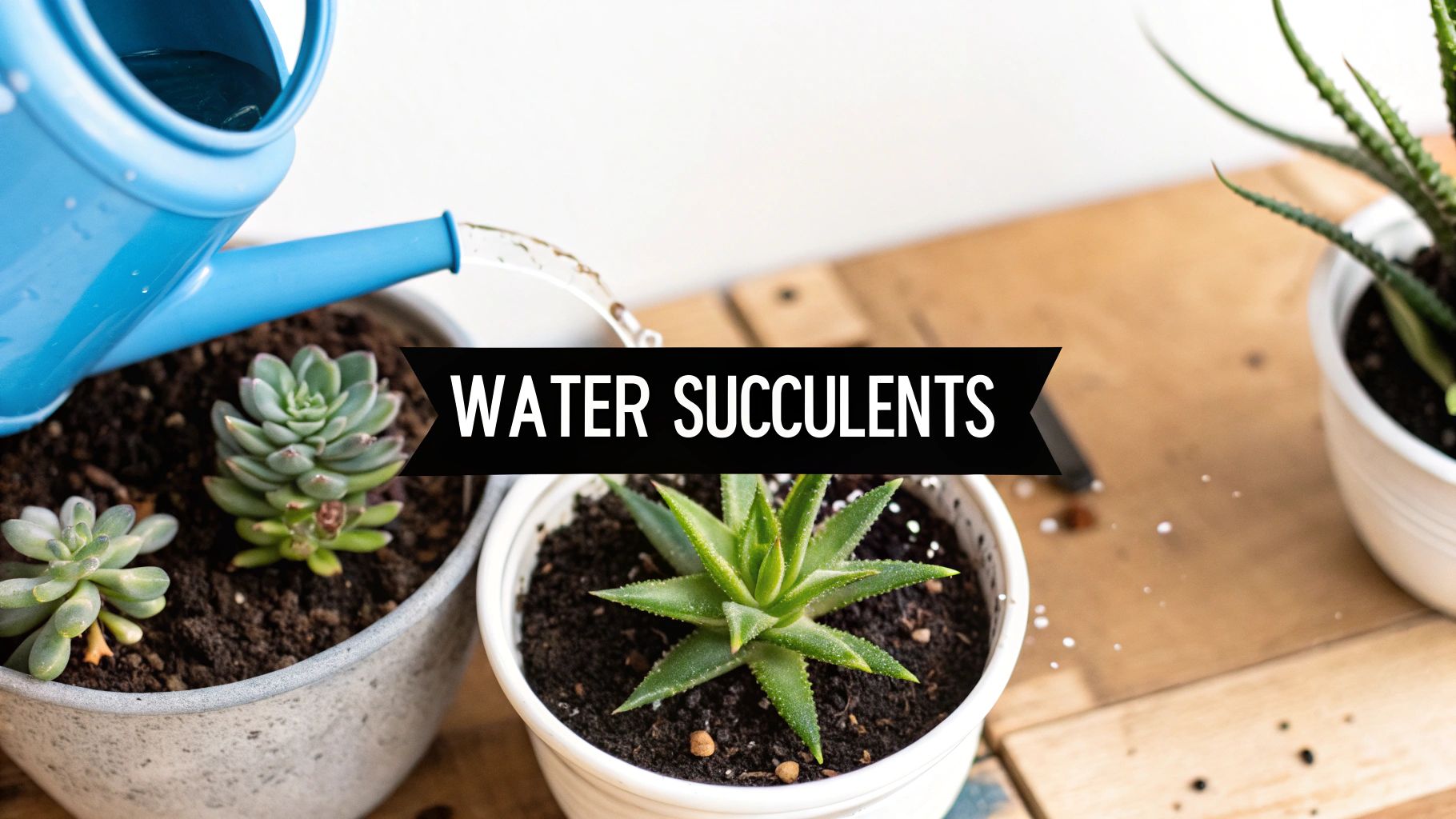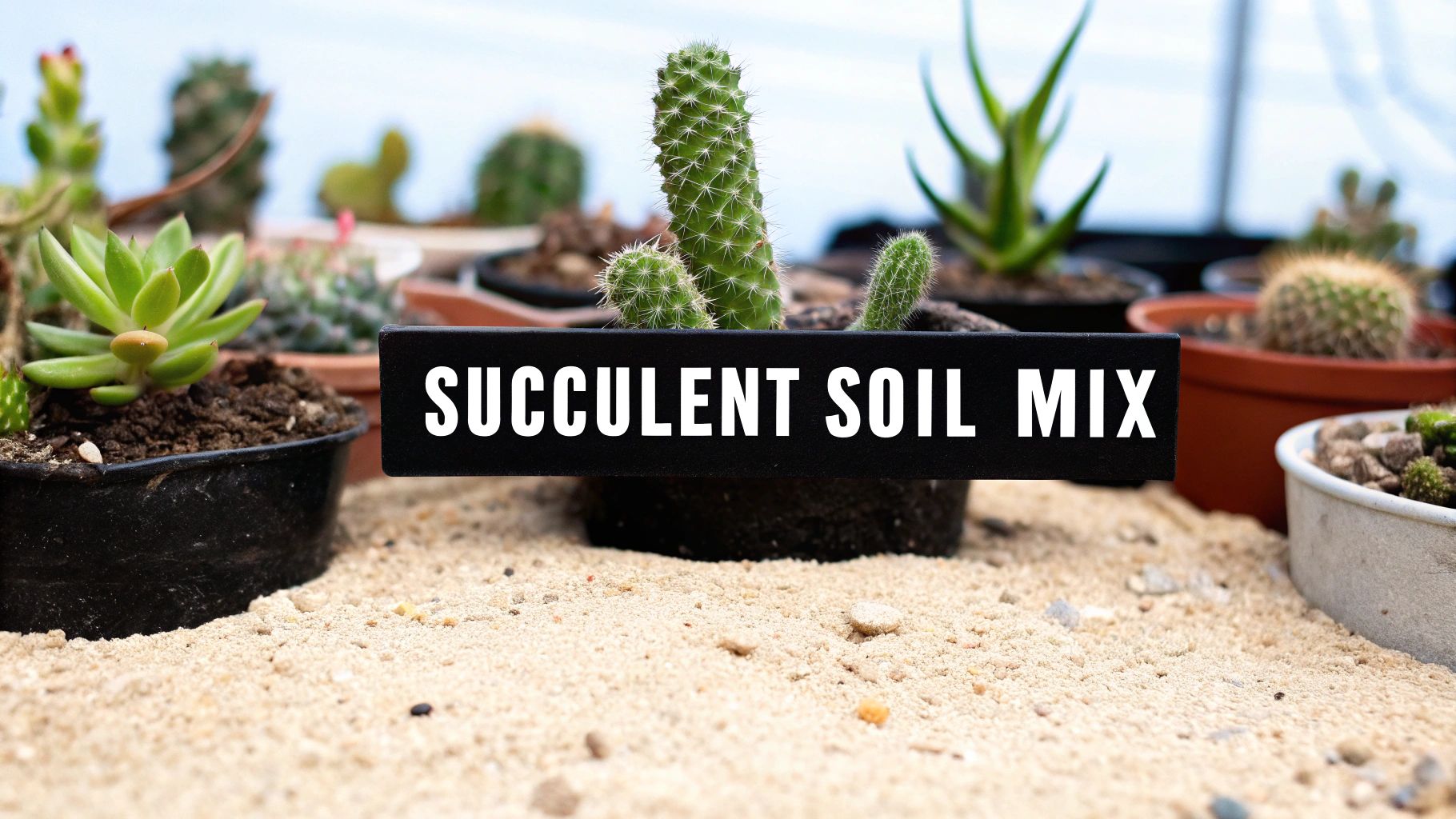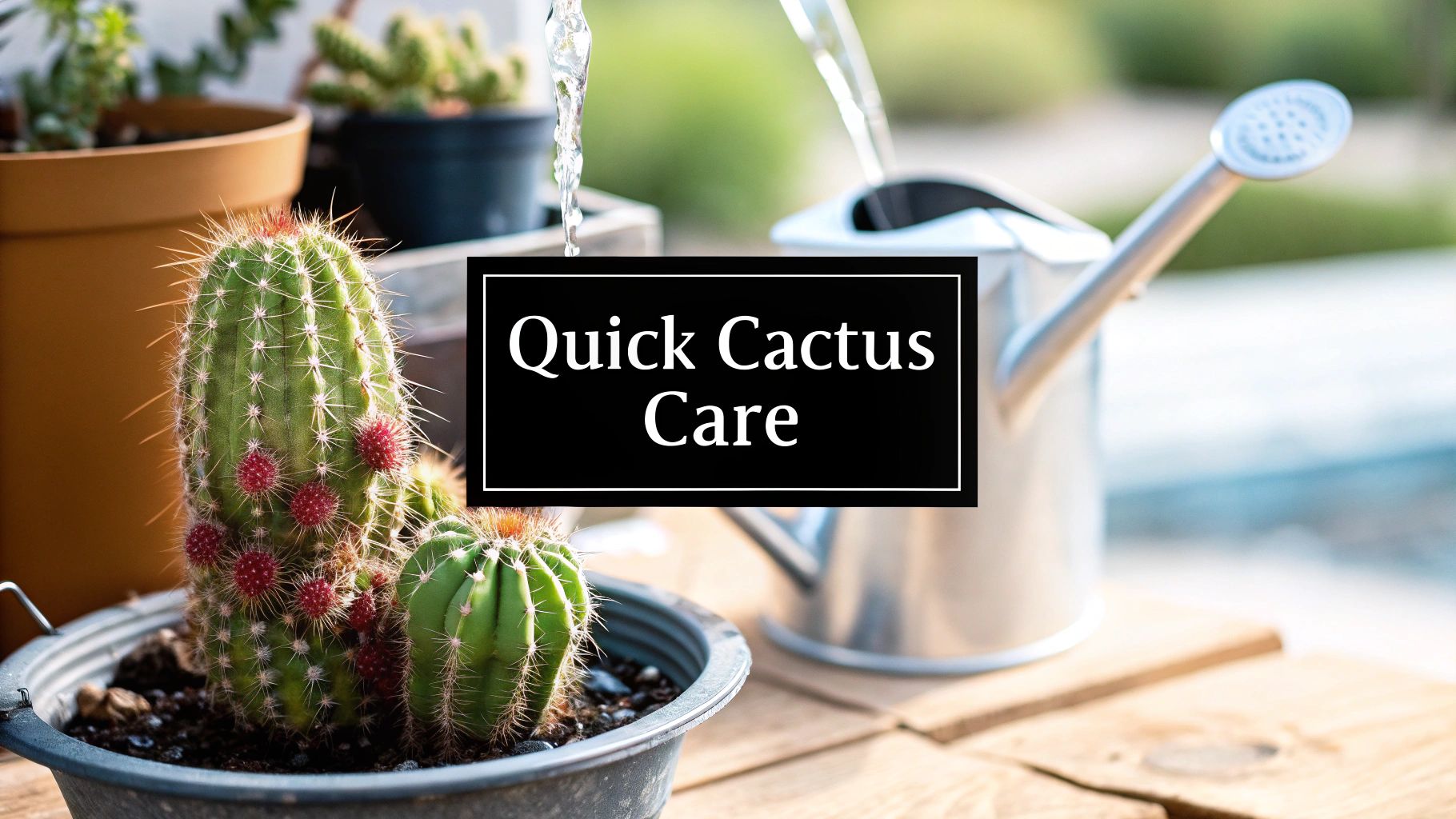When it comes to watering succulents, there's one golden rule that trumps all others: the 'soak and dry' method. It's exactly what it sounds like—you give the soil a thorough drenching and then let it dry out completely before you even think about watering again. This technique is the single best way to prevent root rot because it perfectly mimics the infrequent but heavy rainfall these plants get in their natural desert homes.
Why Your Watering Habits Might Be Harming Your Succulents
If your succulents look unhappy, nine times out of ten, the problem is your watering can. It's a common mistake to treat them like other houseplants, giving them small, frequent sips of water. But that's a surefire way to kill a succulent. These plants are built to handle drought, not a constant state of dampness.
Succulents have evolved to be incredible water hoarders. Plants from families like Aizoaceae and Crassulaceae have thick, fleshy leaves and stems that can be made up of an astonishing 90–95% water. This amazing adaptation means their root systems are extremely sensitive to sitting in wet soil for extended periods. You can find more fascinating details about their unique biology in this comprehensive succulent plant market report.
The Problem with Shallow Watering
Giving a succulent just a little bit of water at a time is a recipe for disaster. For one, the water only penetrates the very top layer of soil. This encourages the plant to grow a weak, shallow root system because that's where the moisture is, leaving the deeper roots to shrivel.
Worse yet, the surface of the soil never truly dries out. This creates the perfect damp, humid environment for fungus and bacteria to thrive, leading directly to root rot—the number one killer of succulents.
The 'soak and dry' philosophy is all about mimicking nature. In the desert, it doesn't just drizzle a little every day. Instead, a torrential downpour soaks the earth, followed by a long, dry spell. Recreating this cycle is the secret to happy, healthy succulents.
The infographic below really brings home the difference between these two watering styles.
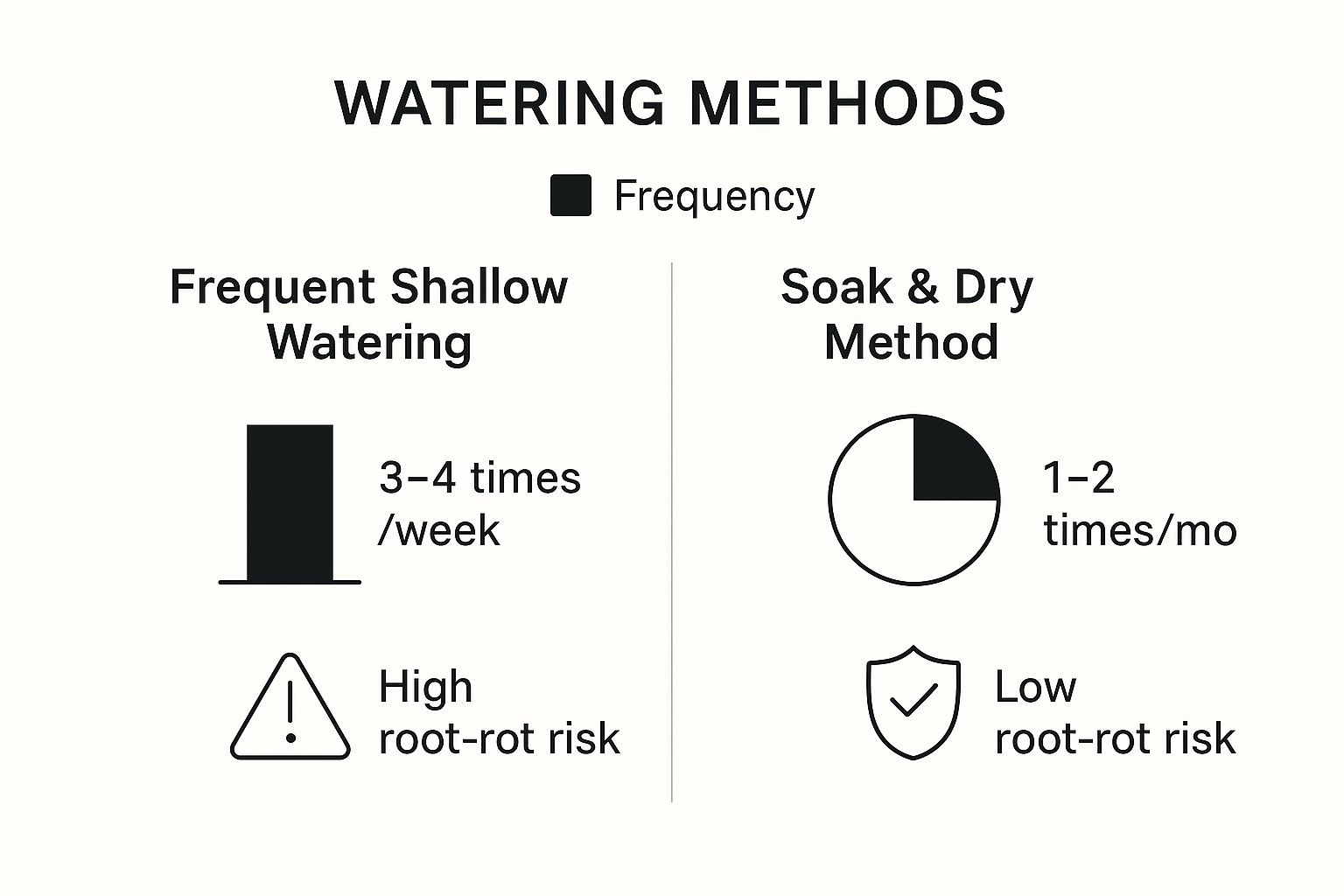
As you can see, the 'soak and dry' method dramatically cuts down on how often you water, which is the key to minimizing the risk of deadly root rot. Getting this principle down is the first step in moving away from a rigid, harmful schedule and toward a more intuitive approach that lets your plants truly thrive.
The Soak and Dry Method in Action
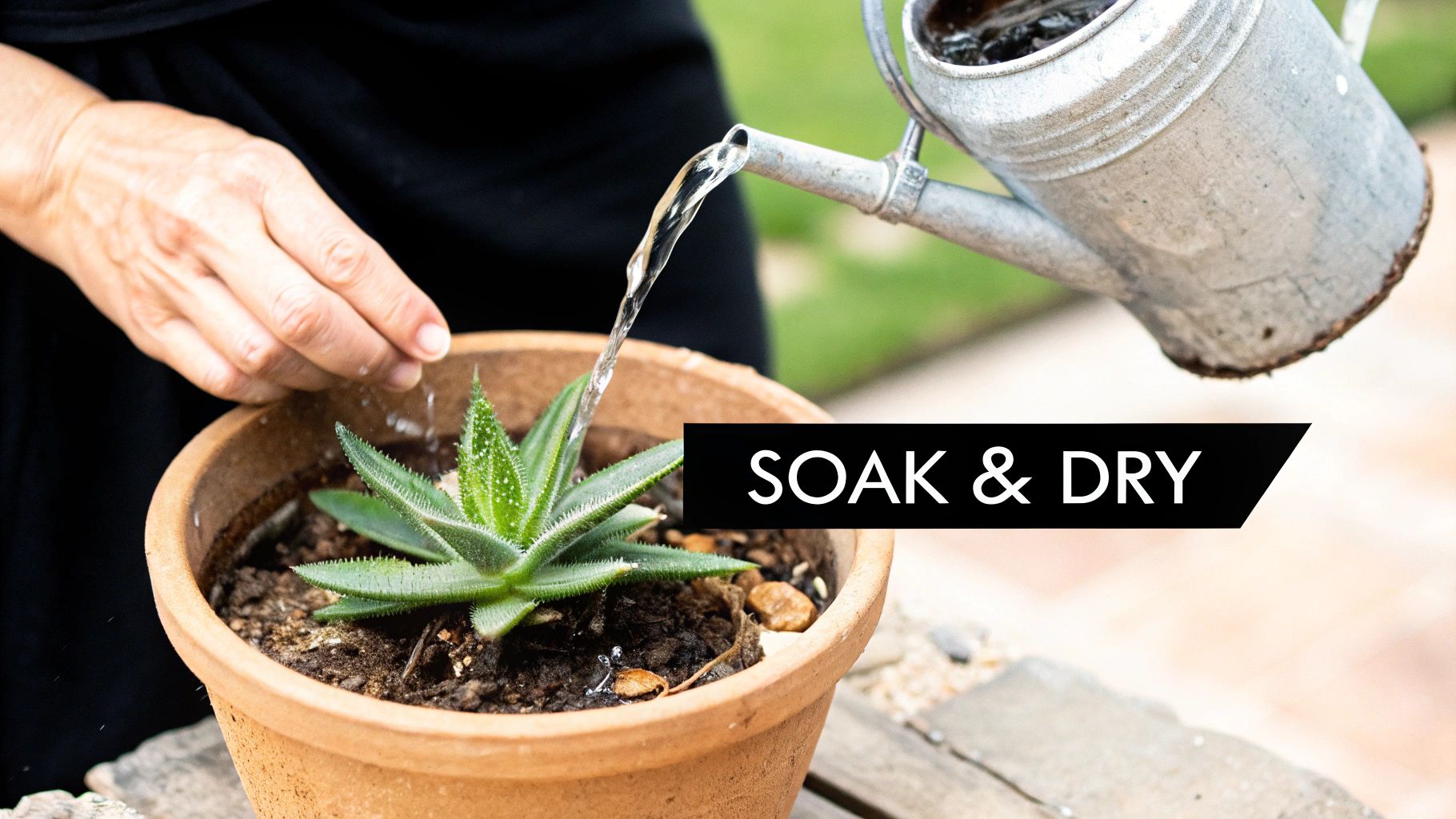
This simple technique is the absolute cornerstone of good succulent care. But just knowing the name isn't enough—getting the feel for it is what really makes the difference. It boils down to two key moments: first, making absolutely sure the soil is dry, and second, giving the plant a really good, deep drink.
Confirming the Soil Is Bone-Dry
Before you even think about grabbing your watering can, you need to play detective. The goal is to verify that the soil has dried out completely, all the way through, not just on the surface.
Here are a few tried-and-true ways I check my own plants:
- The Finger Test: This is the most reliable method. Stick your finger about two inches deep into the soil. If you feel any coolness or moisture at all, hold off on watering. Bone-dry soil will feel dusty and won't cling to your skin.
- Visual Cues: You'll get to know your soil. Dry succulent mix is usually a lighter color than when it’s wet. Sometimes, you'll even see it pull away slightly from the sides of the pot.
- The Weight Trick: Get a feel for your potted plant right after you've watered it. A small Echeveria in a terracotta pot feels surprisingly heavy. When it's completely dry, it'll be noticeably lighter. Simply lifting the pot is a fantastic, non-invasive way to check.
Why is this waiting period so important? It's all about preventing root rot. When you let the soil dry out completely, you're allowing the roots to get the oxygen they need to breathe. This mimics the arid, drought-and-deluge cycles these plants evolved to thrive in.
How to Properly Soak the Soil
Once you're positive the soil is dry, it's time for the "soak." This isn't a delicate sprinkle from above. You want to completely drench the root system until the soil is saturated from top to bottom.
I like to take my succulents to the sink or bring them outside. Pour water slowly and evenly over the soil surface, trying to avoid drenching the leaves and rosettes if you can.
Keep going until you see a generous stream of water flowing freely from the pot’s drainage hole. That’s your sign that the entire root ball has gotten a drink, which encourages the roots to grow deep and strong.
The Final and Most Important Step
After that thorough soak, there’s one last thing you absolutely cannot skip: empty the saucer.
Letting your succulent sit in a puddle of standing water completely undoes all your good work. It’s the fastest ticket to root rot.
Let the pot drain for a few minutes, then be sure to tip out any and all excess water that has collected in the tray or decorative cache pot. Your plant should never, ever be left with "wet feet." Mastering this simple check-soak-drain routine is the real secret to keeping your succulents happy and healthy for years to come.
Learning to Read Your Succulent's Thirst Signals
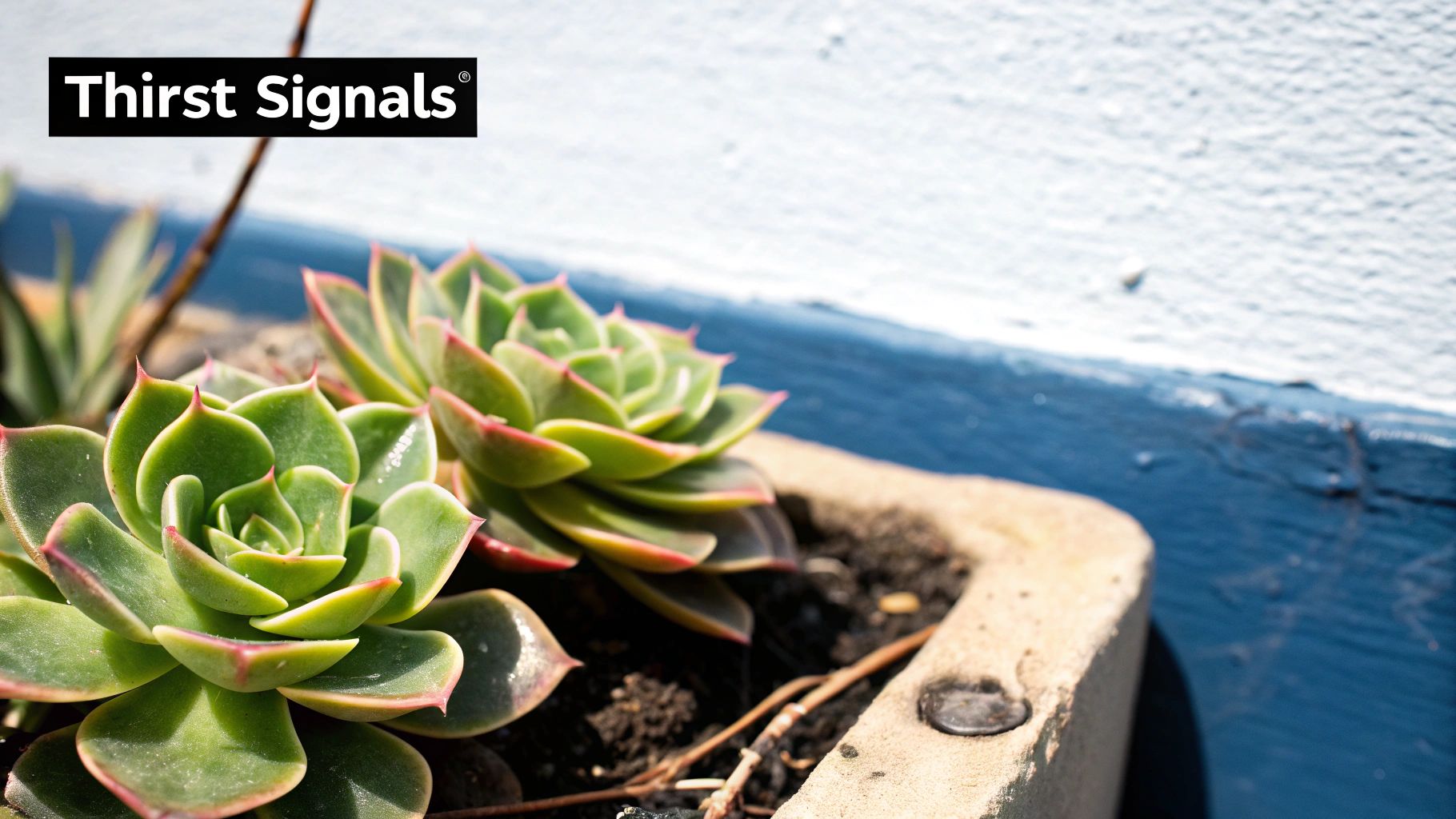
Beyond just checking the soil, the real secret to mastering succulent care is learning to read the plants themselves. Your succulents are always giving you subtle (and sometimes not-so-subtle) cues about whether they're thirsty or drowning. You just have to learn their language.
Once you start paying close attention to the look and feel of their leaves, watering stops being a guessing game. Instead of following a strict calendar, you'll be having a conversation with your plant, giving it a drink exactly when it needs one. This is the key to heading off the most common succulent problems before they even start.
Spotting the Signs of an Overwatered Succulent
If there's one fatal mistake new succulent owners make, it's overwatering. It's the number one cause of succulent death, and the signs can be pretty distinct once you know what you're looking for. When a succulent gets too much water, its cells get so full they can actually burst, leading to a host of issues that usually start underground with the roots.
Here are the key indicators that your plant is waterlogged:
- Mushy, Soft Leaves: Healthy succulent leaves are firm. If they feel squishy or boggy to the touch, that’s a bad sign.
- Translucent or Yellowing Foliage: Overwatered leaves often turn a sickly, pale yellow. They might even look almost see-through as their internal structure breaks down.
- Leaves Dropping Easily: If leaves fall off the stem with just a gentle nudge, it’s a major red flag. This often means root rot has already taken hold.
Spotting these symptoms means you need to act fast. An overwatered Aloe, for example, can turn to mush in no time. If you're dealing with this, our guide on how to save an aloe plant might just be a lifesaver.
The trickiest thing about overwatering is that a dying plant can look plump and healthy right up until the very end. That's why checking the soil and watching for those subtle leaf changes are so critical—they're the earliest warnings you’ll get.
Recognizing a Thirsty, Underwatered Succulent
Now for the good news: the signs of an underwatered succulent are usually way less alarming and much easier to fix. These plants are built for drought, so they'll start showing you they're thirsty long before there's any real danger. Think of it as your plant simply asking for a drink.
A thirsty succulent will often look a bit deflated or stressed. Keep an eye out for these tell-tale signs:
- Wrinkled or Puckered Leaves: The leaves will start to look shriveled, a bit like a grape turning into a raisin, as the plant uses up its internal water stores.
- Soft and Bendable Leaves: Take a Jade plant, for instance. When it's well-hydrated, its leaves are firm and rigid. When it's thirsty, those same leaves become pliable and you can bend them easily.
- Crispy Lower Leaves: Some succulents, especially rosettes like Sempervivum or Echeveria, will sacrifice their oldest, lowest leaves during a dry spell. These leaves will get thin, dry, and crispy as the plant redirects resources to the new growth at its center.
When you see these signs, it’s the perfect time to give your plant a good, deep soak. Unlike the mushy leaves of an overwatered succulent, a thirsty plant will almost always bounce back and look plump again within a day or two of a proper watering.
How Light and Seasons Change Your Watering Schedule
If there’s one habit you need to break to keep succulents happy, it's watering them on a strict calendar schedule. Forget "Watering Wednesdays." The real answer to "how often?" is always, "it depends." The two biggest factors are the amount of light your plant gets and the time of year.
https://www.youtube.com/embed/nYaI_WDTKXE
Think of light as the engine that drives your succulent's thirst. A plant basking in a bright, south-facing window is working hard—photosynthesizing, growing, and using up water much faster than one sitting in a dim corner.
That intense sun also warms up the pot and soil, causing water to evaporate more quickly. So, the succulent in the sunny spot might need a deep watering every 10-14 days in the summer. Meanwhile, its friend in a lower-light spot could easily go a month or more without a drink. Getting to know your plant’s environment is everything. For a deeper dive, our guide to Aloe plant sunlight needs is a great place to start.
Adjusting for Growth and Dormancy
Just as important as light is the season. Succulents don’t grow at a steady pace all year; they cycle through periods of active growth and dormancy. For most popular varieties, like Echeverias and many cacti, the party really gets started in spring and summer.
During these warmer months with longer days, they are pushing out new leaves and roots, so they need more water to fuel all that activity. But as the days get shorter and cooler in fall and winter, they hit the brakes and go dormant. Their metabolism slows way down, and their water needs plummet.
Think of it like this: in summer, your succulent is running a marathon and needs constant hydration. In winter, it's hibernating and barely needs a sip to get by. Overwatering during dormancy is one of the quickest ways to cause root rot because the plant simply isn't using the water.
Creating a Flexible Watering Routine
So, what does this look like in practice? It means you have to become an observer. Your summer routine of watering every two weeks could be a death sentence in the middle of winter.
During the coldest, darkest months, you might only water your succulents once every 4-6 weeks—sometimes even less, depending on your home's climate.
This seasonal shift isn't just a hobbyist's trick; it's a global standard for growing healthy succulents. Watering frequency often moves from weekly during peak summer growth to monthly (or less) in winter dormancy. This careful approach prevents overwatering, which boosts survival rates and supports a stable market. In fact, this kind of precise care is a key driver in the projected 17.9% compound annual growth of the succulent market, which is expected to expand from USD 6.06 billion in 2025 to USD 29.07 billion by 2034. You can discover more insights about the succulent market on businessresearchinsights.com.
By tuning into the light your plant receives and the rhythm of the seasons, you'll develop an intuition that keeps your collection thriving all year long.
Setting Your Succulents Up for Success with the Right Pot and Soil
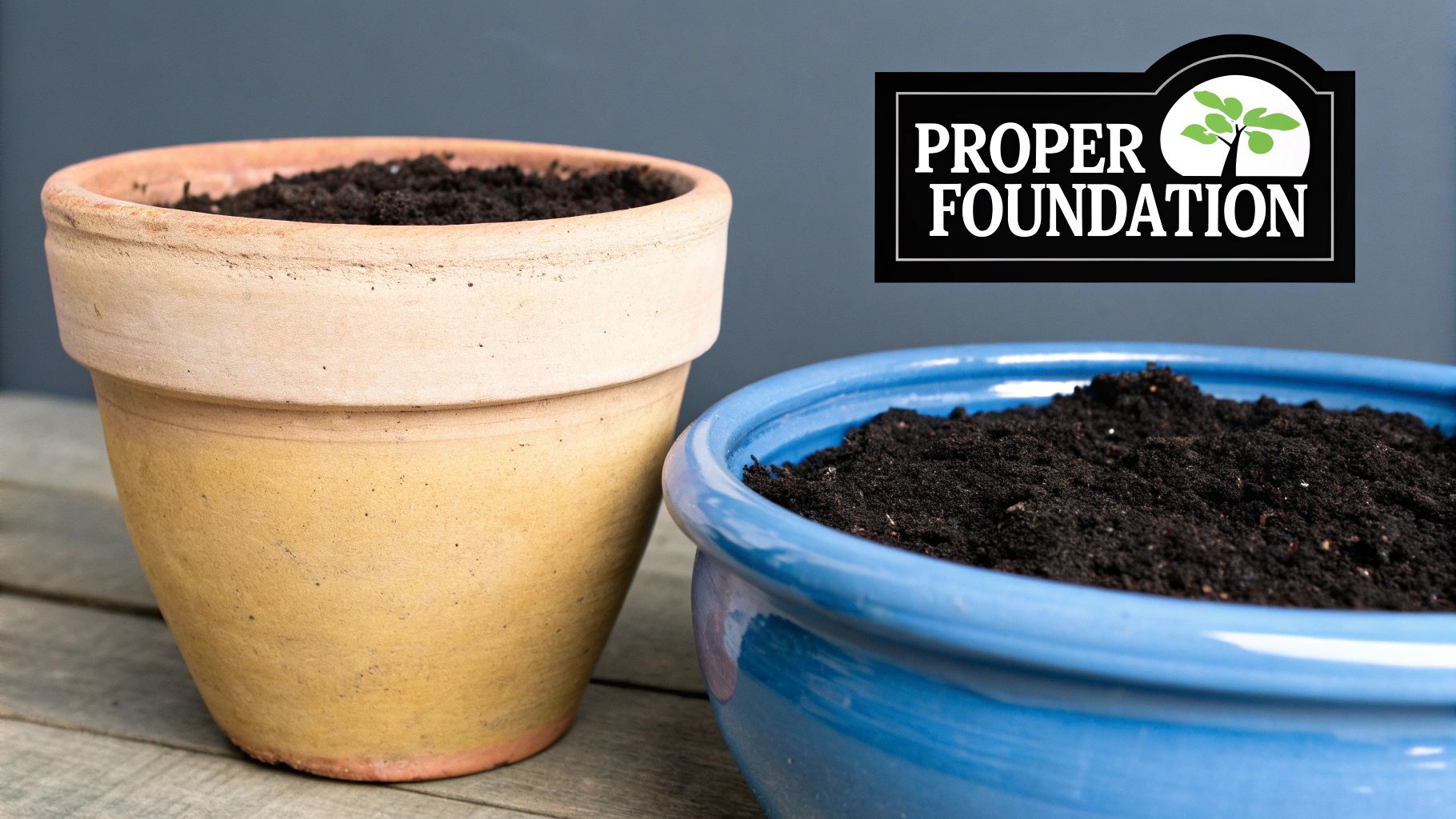
Before you even think about picking up a watering can, let's talk about the foundation. Getting the pot and soil right is more than half the battle when it comes to keeping succulents happy. In fact, if you nail this part, your watering routine becomes a whole lot more forgiving.
The number one, non-negotiable rule? Your pot must have a drainage hole. I can't stress this enough. That little hole at the bottom is the escape hatch for excess water, and it's the single best defense against the dreaded root rot.
Without it, water pools at the bottom, turning the soil into a swampy mess that suffocates the roots. One accidental overwatering in a pot with no drainage can be a death sentence.
Choosing the Right Pot Material
The type of pot you choose has a huge impact on how quickly the soil dries out, which in turn dictates how often you’ll need to water. It’s not just about aesthetics; it’s about airflow and moisture management.
- Terracotta and Clay: These are my go-to, especially for beginners. Because they’re porous, they breathe. They literally pull moisture out of the soil and let it evaporate through the walls of the pot. This means the soil dries out faster, giving you a great buffer against overwatering.
- Glazed Ceramic or Plastic: These pots can be beautiful, but they don't breathe. They're non-porous, trapping moisture inside for much longer. If you use one of these, you have to be much more careful with your watering can and extend the time between drinks significantly.
Think of it this way: a terracotta pot is like wearing a breathable cotton t-shirt on a hot day, while a glazed pot is like wearing a raincoat. One lets moisture out, and the other keeps it all in. Your watering strategy has to change based on what your succulent is "wearing."
Why Your Soil Mix Is So Important
Just as critical as the pot is what you fill it with. Grabbing a bag of standard potting mix is one of the most common mistakes I see. That stuff is designed to hold onto water for thirsty houseplants, which is the exact opposite of what your succulent wants. It’s dense, peaty, and a recipe for root rot.
Succulents need a soil that is gritty, airy, and drains like a sieve. You want water to flush through the pot quickly, giving the roots a good drink on the way down without letting them sit in soggy soil. You can buy a pre-made cactus and succulent mix or easily make your own. For a deep dive into the perfect recipe, check out our guide to cactus and succulent soil.
While there are tons of new "smart" pots on the market, sometimes simple is better. The self-watering pot market is growing, but these are generally a terrible idea for succulents. When 70-80% of succulent problems are caused by overwatering, the last thing you need is a pot designed to keep the soil constantly moist. A basic terracotta pot with a drainage hole and the right gritty soil is still the most foolproof setup you can give your plant. You can learn more about plant pot market trends on persistencemarketresearch.com.
Answering Your Top Succulent Watering Questions
Even when you've got the basics down, certain situations can pop up that make you second-guess your watering can. It's totally normal. Let's tackle some of the most common questions I hear, so you can handle anything your plants throw at you with confidence.
How Soon Can I Water a Succulent After Repotting?
This is a big one, and the answer often surprises people: hold off on watering for at least a week.
I know, it feels wrong. You just gave your plant a new home and you want to tuck it in with a nice drink. But here's the thing: repotting is a bit rough on the roots. It's almost impossible to avoid breaking or bruising some of the tiny, delicate ones.
Giving your succulent a "dry spell" after its move allows those little wounds to heal and form a callus. If you water right away, you risk introducing moisture that can lead straight to root rot before the plant even has a chance to settle in. A little patience now saves a lot of heartache later.
Is It Okay to Use Tap Water for Succulents?
For the most part, yes. Your everyday tap water is usually just fine. Succulents are tough and not particularly picky.
However, if you live somewhere with very "hard" water—water that's full of dissolved minerals—you might start to see a crusty white buildup on the soil or around the rim of your pot. This is mostly a cosmetic issue and rarely causes any real harm.
If the white crust bothers you or if you're growing a particularly fussy variety, switching to rainwater, filtered, or distilled water is an easy fix. Also, if your tap water smells strongly of chlorine, just let it sit out in an open container for about 24 hours. The chlorine will evaporate, and your plant will be happier for it.
My Go-To Tip: I always try to water my succulents in the morning. This gives them the entire day, with plenty of light and air movement, to start drying out. Watering at night can leave the soil sitting cold and damp for too long, which is a perfect invitation for fungus and rot.
Help! My Pot Doesn't Have a Drainage Hole.
A pot without a drainage hole is public enemy number one for a succulent. Honestly, the best and safest thing you can do is repot it into a container that has one. It's a game-changer.
If you're absolutely set on using that specific pot, you'll have to be incredibly careful. Here’s how you can try to make it work, but remember, the risk is high.
- Create a Buffer Zone: Start with a layer of gravel or pebbles at the bottom. This creates a small space for any excess water to pool away from the roots, but it's not a foolproof solution.
- Add Some Charcoal: A thin layer of activated charcoal over the gravel can help keep things from getting stagnant and smelly.
- Water with Extreme Caution: This is the most critical part. You have to give the plant just enough water to moisten the soil and not a drop more. The margin for error is almost zero, as there's nowhere for extra water to go.
Ready to expand your collection with healthy, beautiful plants? At The Cactus Outlet, we offer a stunning selection of large cacti and succulents that are the perfect foundation for your garden. Explore our collection today!

